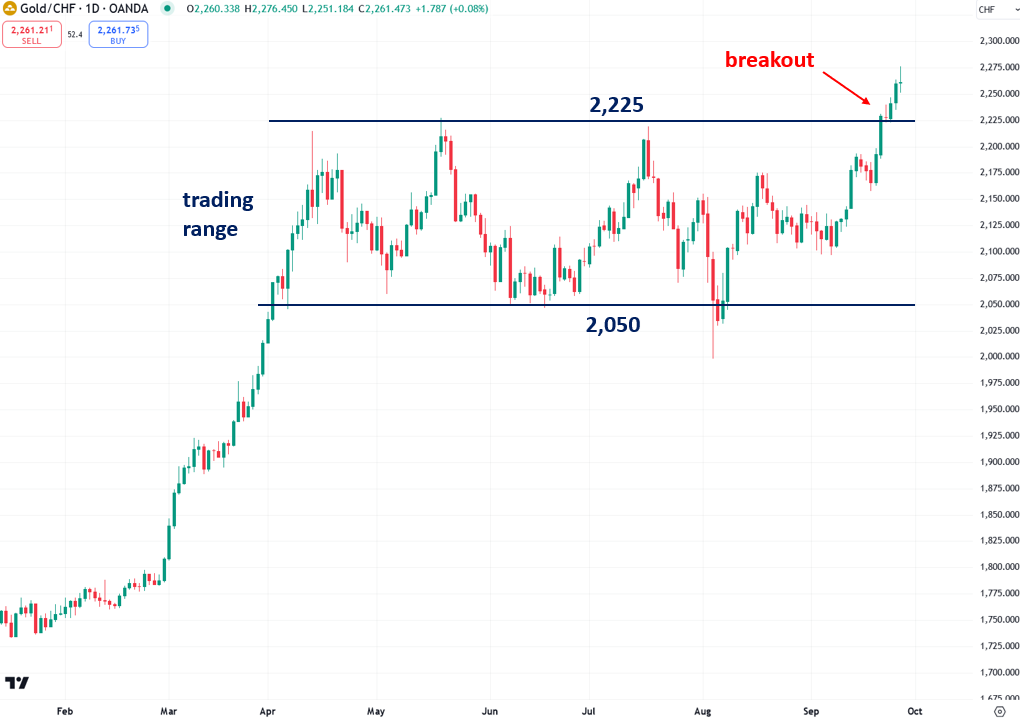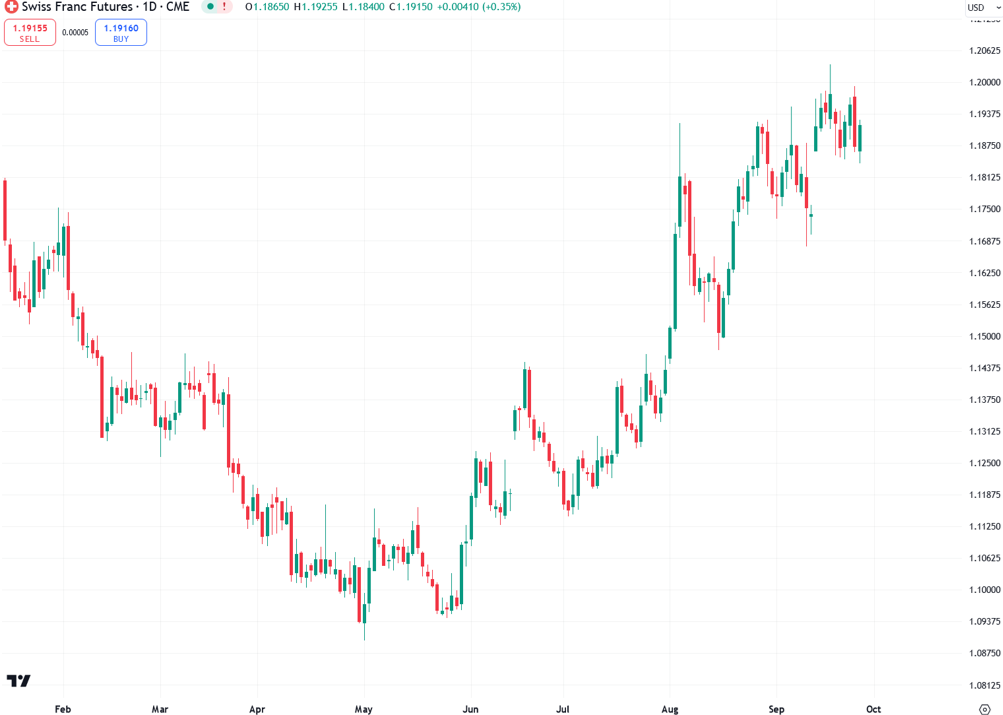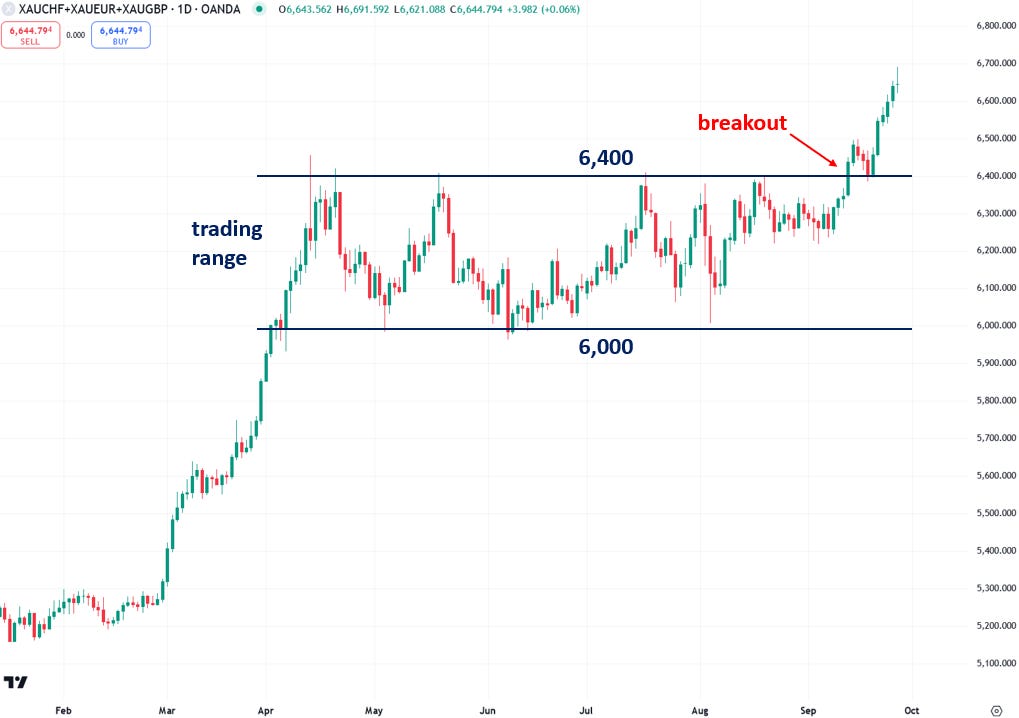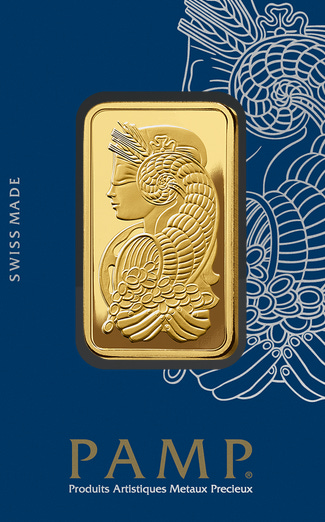One of my preferred methods for analyzing gold and silver is to price them in currencies other than the U.S. dollar—an approach that has proven quite successful. This approach filters out the impact of U.S. dollar fluctuations, revealing the true intrinsic strength of gold and silver. I've also discovered that technical analysis on gold and silver priced in non-U.S. dollar currencies is highly effective, often uncovering insights that remain hidden when analyzing these metals solely in dollars. For instance, using this method, I successfully anticipated the recent surge in gold prices. However, I observed that while gold had already broken out in most currencies, it remained stubbornly resistant in Swiss francs—until now. In this piece, I’ll explain the significance of this breakout.
To start, let’s take a look at the chart of gold priced in Swiss francs or gold/CHF. You’ll notice that gold/CHF traded in a well-defined range between 2,050 and 2,225 for five months. I’ve been stating that a breakout from this range would serve as a particularly strong bullish signal for gold. Switzerland, with its numerous mints, refiners, vaults, and a robust gold trading and banking sector, is a key hub in the global gold industry. Such a breakout is likely to have a significant psychological impact on the Swiss gold industry. Sure enough, the breakout has finally happened.

One reason it took longer for gold/CHF to break out compared to other currencies is that the Swiss franc has been one of the world’s top-performing major currencies this year, making the recent gold/CHF breakout even more momentous.
 On a similar note, I’ve found it valuable to price gold in a combination of Swiss francs, euros, and British pounds for added confirmation. This unique combination revealed an almost perfect 400-point trading range since April, with support precisely at 6,000 and resistance at 6,400. I recognized that a breakout from this range would represent a valuable bullish confirmation signal, and it has certainly proven to be.
On a similar note, I’ve found it valuable to price gold in a combination of Swiss francs, euros, and British pounds for added confirmation. This unique combination revealed an almost perfect 400-point trading range since April, with support precisely at 6,000 and resistance at 6,400. I recognized that a breakout from this range would represent a valuable bullish confirmation signal, and it has certainly proven to be.

For reference, gold priced in U.S. dollars—the standard international benchmark—has surged ever since breaking through the critical $2,475 and $2,525 resistance levels:

As I mentioned earlier, Switzerland has long been one of the world’s most significant hubs for the gold industry, making the breakout in gold priced in Swiss francs particularly noteworthy. To begin with, Switzerland is the world’s largest importer and exporter of gold, primarily because it imports unrefined gold and exports it in refined form. Interestingly, Switzerland doesn’t mine gold domestically. In 2023, Switzerland imported $102.3 billion in gold and exported $107.2 billion, underscoring its pivotal role in the global gold trade.

A PAMP gold bar
Switzerland’s gold refineries including as Argor-Heraeus, Valcambi, Produits Artistiques Métaux Précieux (PAMP), and Metalor Technologies refine approximately 70% of world gold mine production and are renowned for their high-quality, ultra-pure gold bullion products. Most of the gold bars produced by the Swiss refiners are .9999 fine gold, meaning they are 99.99% pure, with only 1 part impurity in every 10,000 parts of gold—a very impressive metallurgical feat! Swiss gold products are renowned for their sleek and elegant design, embodying a timeless aesthetic appeal.
Switzerland is globally recognized as a banking powerhouse, with its leading banks, UBS and Credit Suisse, playing pivotal roles in the gold trading arena. UBS, in particular, stands out as one of only six London Bullion Market Association (LBMA) Full Market Makers, specializing in gold and silver spot trading, forwards, and options. Credit Suisse established its gold trading business in the 1960s and 1970s, rapidly growing to become one of the world’s largest gold dealers by the 1980s.
Other key players in Switzerland's gold market include Raiffeisen Bank, Zürcher Kantonalbank (ZKB), Julius Baer Group, and Pictet & Cie. MKS (Switzerland) SA is a precious metals trading firm and LBMA associate that serves banks, fund managers, gold miners, and jewellery manufacturers and also owns the PAMP refinery. MKS (Switzerland) SA is part of the MKS PAMP Group, which owns the New York City-based gold dealer Manfra, Tordella & Brookes (MTB). Switzerland is also renowned for its ultra-secure gold vaults, including those hidden deep within the Swiss Alps.

A gold vault in the Swiss Alps. Credit: Helvetic News
Despite being a small country, roughly the size of New Jersey, with a population of just 8.9 million, Switzerland holds the world’s seventh-largest gold reserves, totaling 1,040 tonnes and valued at $89.4 billion. The six countries with the largest gold reserves—the United States, Germany, Italy, France, Russia, and China—boast significantly larger economies and populations compared to Switzerland. Central banks maintain a portion of their reserves in gold to diversify their holdings, as gold is a time-tested safe-haven asset with no counterparty or default risk.
To summarize, the recent breakout of gold priced in Swiss francs marks an important confirmation for the bull market in gold. This breakout, especially significant given the strength of the Swiss franc, underscores the momentum and staying power behind the 2024 gold rally. Switzerland, with its extensive network of mints, refiners, vaults, and a robust gold trading and banking sector, is a pivotal hub in the global gold industry, and this breakout is likely to have a meaningful psychological impact on the professionals and companies within it.
If you enjoyed this article, be sure to check out my recent piece, “Why Another Chinese Gold Mania May Be Starting.

